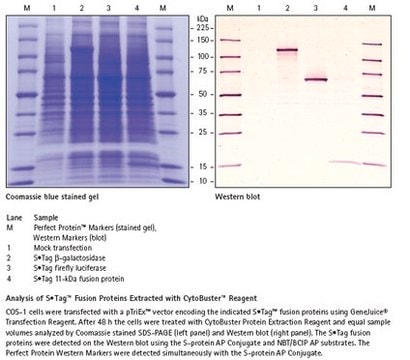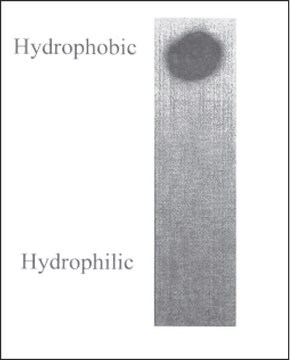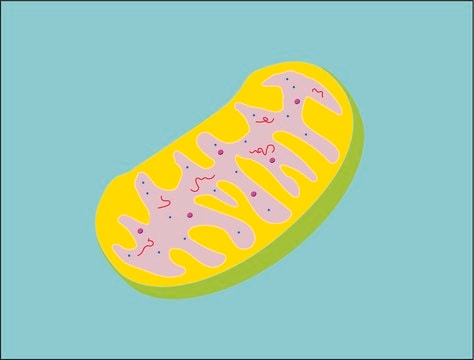Alle Fotos(1)
Wichtige Dokumente
C0356
Protein Extraction Reagent Type 4
Synonym(e):
Protein extraction solution
Anmeldenzur Ansicht organisationsspezifischer und vertraglich vereinbarter Preise
Alle Fotos(1)
About This Item
UNSPSC-Code:
41116012
NACRES:
NA.56
Empfohlene Produkte
Allgemeine Beschreibung
Protein Extraction Reagent Type 4, is a highly premixed, prequalified and effective protein solubilization and extraction reagent composed of urea, thiourea, Trizma®, and detergent C7BzO (C0856).
Anwendung
Protein extraction reagent type 4 is optimized for proteomic studies. Cellular and organelle membrane solubilizing reagent is ideal for protein extraction prior to isoelectric focusing and 2D electrophoresis. Reducing and alkylating reagents TBP (T7567) and iodoacetamide (A3221) are recommended for use with this reagent. Protein extraction reagent type 4 is also available as a component of the ProteoPrep® Sample.
Komponenten
Contains urea, thiourea, Trizma®, and detergent C7BzO (C0856).
Rechtliche Hinweise
ProteoPrep is a registered trademark of Merck KGaA, Darmstadt, Germany
Trizma is a registered trademark of Merck KGaA, Darmstadt, Germany
Signalwort
Warning
H-Sätze
Gefahreneinstufungen
Acute Tox. 4 Oral - Aquatic Chronic 2 - Carc. 2 - Repr. 2
Lagerklassenschlüssel
11 - Combustible Solids
WGK
WGK 3
Flammpunkt (°F)
Not applicable
Flammpunkt (°C)
Not applicable
Persönliche Schutzausrüstung
dust mask type N95 (US), Eyeshields, Faceshields, Gloves
Analysenzertifikate (COA)
Suchen Sie nach Analysenzertifikate (COA), indem Sie die Lot-/Chargennummer des Produkts eingeben. Lot- und Chargennummern sind auf dem Produktetikett hinter den Wörtern ‘Lot’ oder ‘Batch’ (Lot oder Charge) zu finden.
Besitzen Sie dieses Produkt bereits?
In der Dokumentenbibliothek finden Sie die Dokumentation zu den Produkten, die Sie kürzlich erworben haben.
Kunden haben sich ebenfalls angesehen
Meritxell Pérez-Hedo et al.
Proteome science, 10(1), 58-58 (2012-10-02)
Sesamia nonagrioides is a noctuid that feeds on maize, sugar cane and sorghum in North Africa and Southern Europe. Larvae reared under long day conditions pupate after 5 or 6 larval instars, whereas larvae reared under short day conditions enter
John McCarthy et al.
Journal of proteome research, 2(3), 239-242 (2003-06-20)
Carbamylation is widely quoted as being a problem in 2-D gel analysis and the associated sample preparation steps. This modification occurs when iso-cyanate, a urea break-down product, covalently modifies lysine residues, thus inducing a change in isoelectric point. Urea is
Chawalit Kocharunchitt et al.
Molecular & cellular proteomics : MCP, 11(1), M111-M111 (2011-10-20)
An integrated transcriptomic and proteomic analysis was undertaken to determine the physiological response of Escherichia coli O157:H7 Sakai to steady-state conditions relevant to low temperature and water activity conditions experienced during meat carcass chilling in cold air. The response of
Ariadna Peremarti et al.
BMC genomics, 15, 125-125 (2014-02-14)
Leaf pigment content is an important trait involved in environmental interactions. In order to determine its impact on drought tolerance in wheat, we characterized a pale-green durum wheat mutant (Triticum turgidum L. var. durum) under contrasting water availability conditions. The
Gabriel A Grilo et al.
Journal of molecular and cellular cardiology, 139, 62-74 (2020-01-25)
Age-related remodeling of the heart causes structural and functional changes in the left ventricle (LV) that are associated with a high index of morbidities and mortality worldwide. Some cardiac pathologies in the elderly population vary between genders revealing that cardiac
Unser Team von Wissenschaftlern verfügt über Erfahrung in allen Forschungsbereichen einschließlich Life Science, Materialwissenschaften, chemischer Synthese, Chromatographie, Analytik und vielen mehr..
Setzen Sie sich mit dem technischen Dienst in Verbindung.














